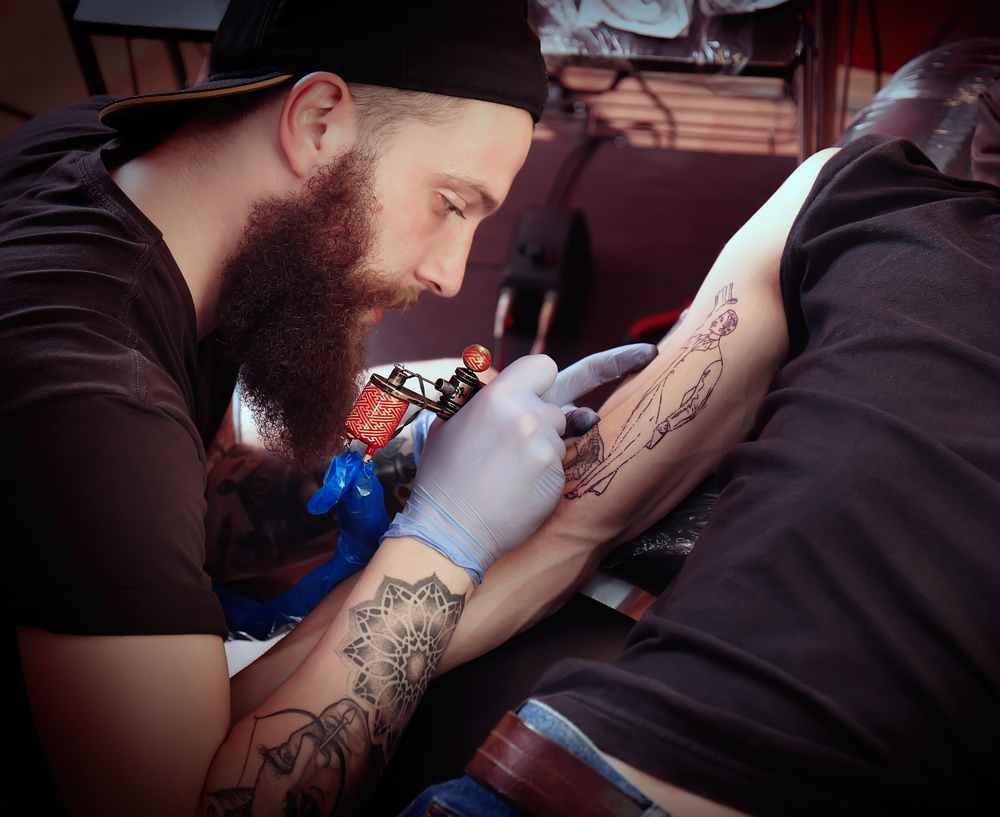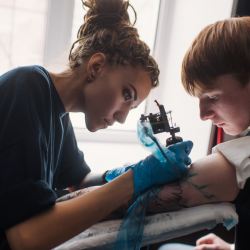As the time-honored saying goes, it's better to give than to receive.
Well, maybe not always – especially when it comes to tattoo artists.
When these workers ply their creative trade, they must bend over their customers and maintain steady positions, sometimes for hours at a time – and the physical strain they must endure on a given workday can be significant. That's the key finding of the first-ever study of its kind, researchers say, measuring muscle stress of tattoo artists at work.
In this small study of parlor workers, researchers from Ohio State University found that "all of them exceeded maximums recommended to avoid injury, especially in the muscles of their upper back and neck," according to a OSU media release. They must hunch over their flesh canvasses, bring their faces to within just inches of their ink pens, held by clenched hands – all while trying to remain steady. They also must usually sit for long stretches of time, which in itself – as we've noted previously – can pose a health problem.
All of these requirements combined often paint a troubling health picture for the artists. And as a group they are plagued with similar types of discomfort and injuries as dentists and dental hygienists, who also must spend their workday leaning towards and hovering over their patients. Except there's one main difference.
"There's no such thing as an official 'tattoo chair,' so artists adapt dental chairs or massage tables to make a client comfortable, and then they hunch over the client to create the tattoo," said Carolyn Sommerich, director of the Engineering Laboratory for Human Factors/Ergonomics/Safety at the university. She worked with former master’s student Dana Keester, the co-author of the study.
 Part of the reason to undertake such a study is that tattoos continue to be in demand, which widens the market for artists who deliver them.
Part of the reason to undertake such a study is that tattoos continue to be in demand, which widens the market for artists who deliver them.
"The growth in popularity and acceptability of tattooing has led to increasing numbers of people working in the body modification industry in general and specifically as tattoo artists," the authors wrote in their study, titled, "Investigation of musculoskeletal discomfort, work postures, and muscle activation among practicing tattoo artists," which was published this week in the journal Applied Ergonomics. "There were estimated to be about 55,000 people employed in the tattoo industry in the US in 2015, and that number is expected to increase to about 77,500 by 2020."
Quoting from the study, "Twenty-eight male and six female tattoo artists participated in the questionnaire phase ... ranging in age from 26 to 54 years." Twelve of those were asked to "participate in the observational portion" of the study. Ten eventually agreed to be monitored at work, which the researchers believed had never been done before. Each artist was applied with a series of wireless electrodes which gathered data from the muscles on their upper back and neck for 15 seconds every three minutes.
"Most notable was the strain on their trapezius muscles – upper back muscles that connect the shoulder blades to either side of the neck," states the release, "a common site for neck/shoulder pain. Some exceeded limits by as much as 25 percent, putting them at high risk for injury." Other common injuries include headaches and eye pain.
Delivering tattoos may be an expanding occupation, but it's not represented by an organization or association that provides guidance regarding sound ergonomic practices. In addition, with so many artists being freelance workers and independent contractors, they almost never benefit from workers' compensation protections.

